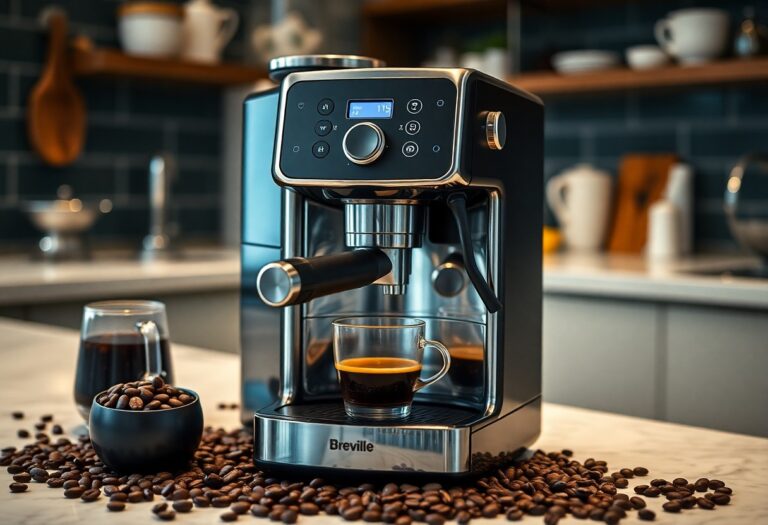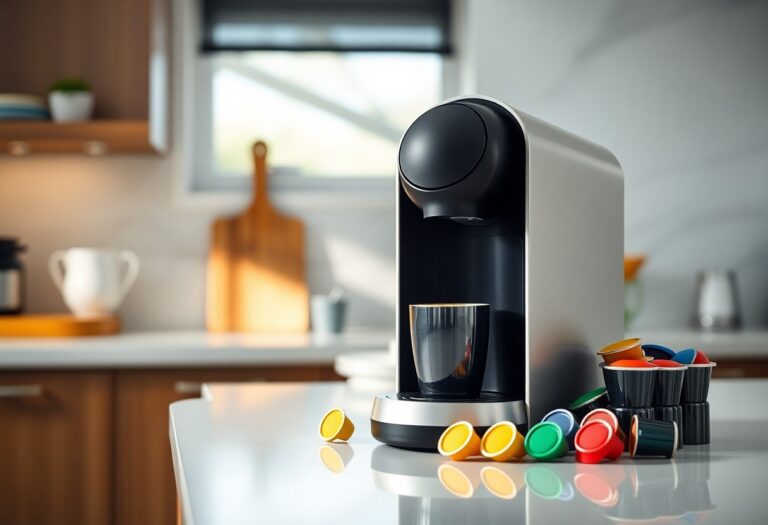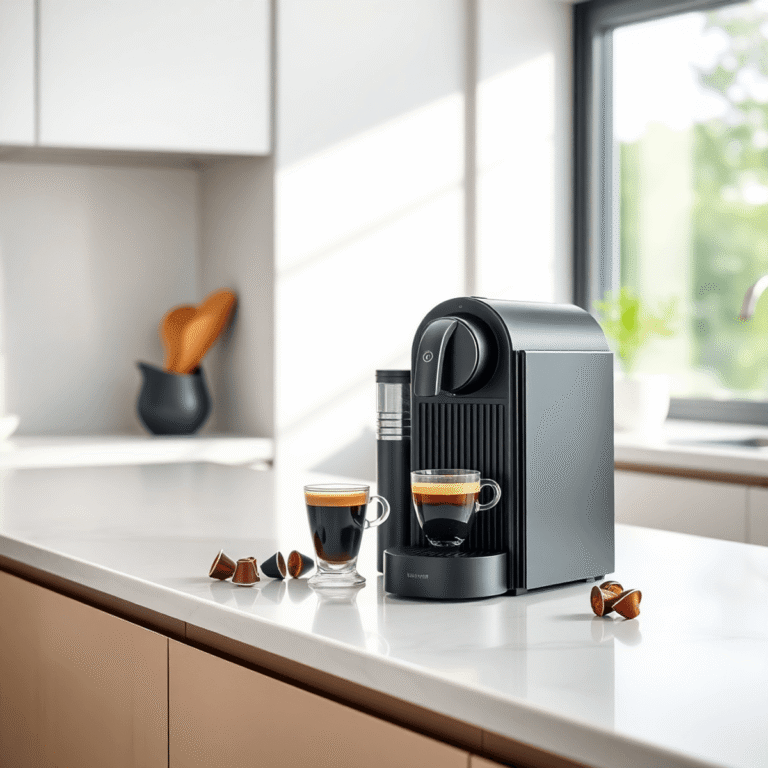What to Use to Clean a Coffee Machine – Cleaning Products
Cleaning your coffee machine is crucial for maintaining the taste and quality of your brews. You might be surprised to learn that the right cleaning products can make all the difference in eliminating buildup and ensuring optimal performance. Options like vinegar, citric acid, or specialized cleaning tablets can effectively tackle mineral deposits and old coffee oils. However, it’s important to avoid harsh chemicals that could harm your machine or affect the flavor of your coffee. Equip yourself with the appropriate cleaning supplies to enjoy a consistently great cup.

Key Takeaways:
- Use a mixture of equal parts water and white vinegar for a natural cleaning solution to remove coffee stains and mineral build-up.
- For deeper cleaning, consider using specialized coffee machine cleaning tablets, which are designed to dissolve residues effectively.
- Avoid using bleach or harsh chemicals that can damage the components of the coffee machine and alter the taste of future brews.
- Regularly washing removable parts, like the carafe and filter basket, with soapy water helps maintain cleanliness and freshness.
- Rinse thoroughly after cleaning to ensure no cleaning product residue remains that could affect the flavor of your coffee.
The Essential Cleaning Agents for Your Coffee Machine
Knowing the right cleaning products to use is vital for maintaining your coffee machine’s performance. Common household ingredients like vinegar and baking soda stand out for their effectiveness and eco-friendliness. For a more thorough guide, check out Cleaning 101: How to Deep Clean a Coffee Maker. Incorporating these agents into your cleaning routine will not only enhance your brew but also prolong the life of your machine.
Vinegar: Nature’s Descaler
Vinegar is a powerhouse when it comes to descaling your coffee machine. Its acidity effectively breaks down mineral buildup caused by hard water, ensuring a cleaner brew and better-tasting coffee. Simply mix equal parts of vinegar and water to create a natural cleaning solution that’s safe and efficient.
Baking Soda: The Deodorizer and Cleaner
Baking soda acts as a gentle abrasive that helps eliminate stubborn stains and odors in your coffee machine. Its natural deodorizing capabilities make it an ideal choice to maintain freshness. To use, combine it with warm water to create a paste, applying it to both the exterior and interior of your coffee maker.
When using baking soda, remember that its effectiveness lies in its ability to neutralize odors. You can add a couple of tablespoons directly into your brew basket before running a brew cycle with water. This method will help cleanse and deodorize the internal components of your machine, leaving your coffee free from musty tastes or smells.
Commercial Cleaners: Pros and Cons
Commercial cleaners offer convenience but come with their trade-offs. While these products are specifically formulated for coffee machines, it’s vital to be aware of what you are using. Evaluating the benefits and drawbacks can help you make an informed decision.
| Pros | Cons |
|---|---|
| Convenient and easy to use | May contain harsh chemicals |
| Targeted formulations for coffee machines | Can be more expensive than DIY options |
| Good for tackling tough stains and buildup | Some may leave residual tastes |
| Speedy results with minimal effort | Potential safety concerns for sensitive components |
| Widely available in stores | You may need to follow specific instructions |
Deciding on commercial cleaners involves weighing their convenience against potential downsides. While many are effective and designed specifically for coffee machines, concerns exist about residual chemicals affecting flavor. It’s wise to select reputable brands and follow usage guidelines closely to get the most out of these specialized products.

Step-by-Step Cleaning Process
The step-by-step cleaning process ensures your coffee machine stays fresh and functional, enhancing your daily brew. Start by gathering required products like vinegar or commercial descaling solutions, warm water, and a clean cloth. For a detailed guide, refer to this handy resource on How to Clean a Coffee Maker for a Better Tasting Cup of Joe. Below is an outline of the imperative steps:
| 1. Unplug the machine and disassemble it. |
| 2. Clean removable parts with warm, soapy water. |
| 3. Run a vinegar or descaling solution through the machine. |
| 4. Rinse with water to remove residue completely. |
| 5. Wipe the exterior with a damp cloth. |
| 6. Reassemble and plug the machine back in. |
Daily Maintenance: Quick Clean Habits
Daily maintenance ensures your coffee machine remains in top shape with minimal effort. After brewing, always rinse the carafe and filter basket to prevent coffee residue build-up. Wipe down the exterior and the brew area with a damp cloth to keep it clean and hygienic. Implement a quick clean routine, and your coffee maker will reward you with consistently delightful brews.
Deep Cleaning: When and How to Do It
Scheduling a deep cleaning every month is vital to prevent mineral build-up and retain the flavor of your coffee. This process typically involves descaling using a vinegar solution or a commercial descaler. Depending on your water hardness and usage, adopting a monthly deep cleaning roster can significantly enhance your coffee’s taste and prolong the life of your machine.
During deep cleaning, make sure to run the solution through the machine at least twice, followed by a couple of water cycles to ensure all residue is removed. Moreover, do not overlook the water reservoir, as stagnant liquid can harbor bacteria. By following this routine, your coffee machine will always be ready to serve you the best cup.
Troubleshooting: Addressing Common Issues
If you encounter problems like weak coffee or scale deposits, immediate action is needed. Start by assessing if the coffee grounds are too coarse or if the machine needs descaling. Clean any clogged parts, and consider replacing old filters to improve performance. Simple troubleshooting can often solve these common issues and ensure your coffee remains rich and flavorful.
In cases where your coffee machine produces a strange taste or odor, it may be an indication of mold or a lack of thorough cleaning. Pay attention to the water reservoir and brewing components, as these are often the culprits. Regular maintenance and timely troubleshooting can significantly enhance your coffee-making experience and overall machine longevity.
The Impact of Cleanliness on Coffee Flavor
The cleanliness of your coffee machine directly influences the flavor of your brew. Residue buildup from oils and minerals can impart unpleasant, stale flavors to your coffee, masking the rich profile of the beans. A thorough cleaning routine helps to preserve the original taste by preventing contamination, ensuring every cup is as delightful as the last.
The Science of Coffee Oils and Residue
Coffee oils and residue accumulate over time, creating an environment where rancidity can develop. These oils trap flavors and odors, leading to the alteration of your coffee’s aroma and taste. The flavor compounds from previously brewed coffee can linger, mistakenly flavoring your next cup. Regular cleaning minimizes this problem, allowing your coffee’s true character to shine through.
Taste Tests: Clean vs. Dirty Machines
Experimentation has demonstrated that brewing coffee in clean machines yields a noticeably superior flavor compared to brewing in dirty ones. Taste tests reveal a stark contrast; coffee brewed in well-maintained equipment boasts clearer, brighter notes, while coffee from neglected machines often tastes dull or even bitter.
In one study involving blind taste tests, participants consistently preferred coffee from freshly cleaned machines, often rating it 30% higher in overall flavor satisfaction. Clean machines allowed flavors to be more pronounced, with nuances in acidity and sweetness highlighted. Conversely, coffee from dirty machines frequently had off-flavors, with many tasters detecting a persistent, musty aftertaste. This stark difference underscores how vital regular maintenance is for achieving the perfect cup, showcasing the critical role cleanliness plays in your coffee ritual.
Eco-Friendly Alternatives for the Conscious Brewer
Choosing eco-friendly cleaning options helps you maintain your coffee machine while being mindful of the planet. Opting for natural solutions ensures that harmful chemicals do not end up in your waste system. By incorporating biodegradable and sustainable cleaning products into your routine, you can keep your beloved brew equipment clean and operate without damaging your health or the environment.
Composting Coffee Grounds: A Sustainable Practice
Instead of tossing used coffee grounds, consider composting them. This sustainable practice not only provides a nutrient boost to your garden soil but also reduces waste. Coffee grounds can improve soil aeration, drainage, and encourage healthy microbial activity, turning your organic waste into an eco-friendly resource.
Natural Store-Bought Alternatives: What’s Available?
Numerous natural store-bought alternatives exist to clean your coffee machine without synthetic chemicals. Popular options include citric acid-based cleaners, vinegar, and products specifically labeled as eco-friendly, which typically contain plant-based agents. These alternatives effectively remove buildup, scale, and coffee oils without compromising your health or the environment.
Notable brands like EcoClean, Urnex, and Brew Rite offer specially formulated solutions that utilize natural ingredients. For instance, EcoClean features biodegradable cleaners that harness the power of citric acid, while Urnex’s Full Circle uses organic components, ensuring your machine remains spotless without harsh residues. Each product usually gives clear instructions for optimal usage, ensuring that cleaning your coffee machine aligns with your sustainability goals.
Expert Opinions on Coffee Machine Care
Insights from experienced baristas and coffee professionals reveal invaluable practices for maintaining your coffee machine. Regular maintenance not only prolongs the lifespan of your equipment but also improves the quality of your coffee. According to experts, the key lies in knowing which cleaning products to utilize and how often to perform routine cleanings, ensuring your machine remains in peak condition.
Insights from Baristas: What Really Works
Baristas stress the importance of using descaling agents and commercial cleaning solutions tailored for coffee machines for the best results. They recommend descaling every 2-3 months, especially if you have hard water. Additionally, daily cleaning of the brew group and regular flushing of the machine can prevent buildup and contribute to a richer flavor profile.
Industry Secrets: Professional Tips for Home Brewers
To elevate your coffee experience, industry insiders share tips such as using filtered water for brewing and routinely cleaning not just the machine, but also the grinder. This can mitigate oils and residue that compromise taste. A thorough cleaning regimen can even include dismantling and cleaning individual parts to ensure every drop of coffee is pure.
- descaling agents improve machine efficiency
- commercial cleaning solutions target coffee oils
- filtered water enhances flavor
- After understanding these expert opinions, you’ll see the benefits of proper care in your daily brews.
Industry insiders recommend employing strategies such as soaking removable parts in a baking soda water mixture to break down oils, which is a gentler approach than some commercial chemicals. They advise against using bleach or vinegar, which can leave residues detrimental to flavor. Your coffee machine thrives with consistent and careful attention, ensuring each cup maintains its quality.
- baking soda is a safe cleaning option
- bleach and vinegar can harm flavor
- removable parts should be cleaned regularly
- After implementing these industry secrets, your at-home brewing will reach barista-level quality.
Final Words
Presently, to maintain the longevity and performance of your coffee machine, you should consider using a combination of vinegar, baking soda, or specialized coffee machine cleaners. These products effectively remove mineral buildup and coffee residue, ensuring your brews remain fresh and flavorful. It’s crucial to follow your machine’s manufacturer instructions for the best results. Regular cleaning not only enhances the taste of your coffee but also extends the life of your appliance, giving you a consistently enjoyable coffee experience.
FAQ
Q: What types of cleaning products are safe to use on a coffee machine?
A: It’s recommended to use products specifically designed for coffee machines, such as descaling solutions or coffee maker cleaners that contain citric acid or vinegar. These solutions effectively remove mineral buildup and coffee oils without damaging the machine. Always check the manufacturer’s instructions before using any cleaning product.
Q: How often should I clean my coffee machine?
A: It’s advisable to clean your coffee machine every three to six months, depending on usage and water hardness. If you use your coffee maker daily, consider more frequent cleaning to maintain optimal performance and taste. Additionally, daily rinsing of removable parts can help reduce build-up.
Q: Can I use vinegar to clean my coffee machine?
A: Yes, vinegar is a popular natural cleaning agent for coffee machines. To use it, mix equal parts of white vinegar and water and run a brewing cycle. Afterward, run a few cycles with clean water to rinse away any vinegar residue. However, check your appliance’s guidelines, as some manufacturers do not recommend vinegar due to its acidity.
Q: What should I avoid when cleaning my coffee machine?
A: Avoid using abrasive cleaners, scouring pads, or harsh chemicals that can scratch surfaces or interfere with components. Also, steer clear of bleach or any product not designed for coffee machines, as they can leave harmful residues or permanently damage the appliance.
Q: Are there any eco-friendly cleaning options for my coffee machine?
A: Yes, there are eco-friendly cleaning products available that are safe for coffee machines, often using ingredients like citric acid or baking soda. Additionally, natural solutions such as a vinegar and water mixture can be used. Always check labels to ensure they are safe and effective for your specific machine type.







